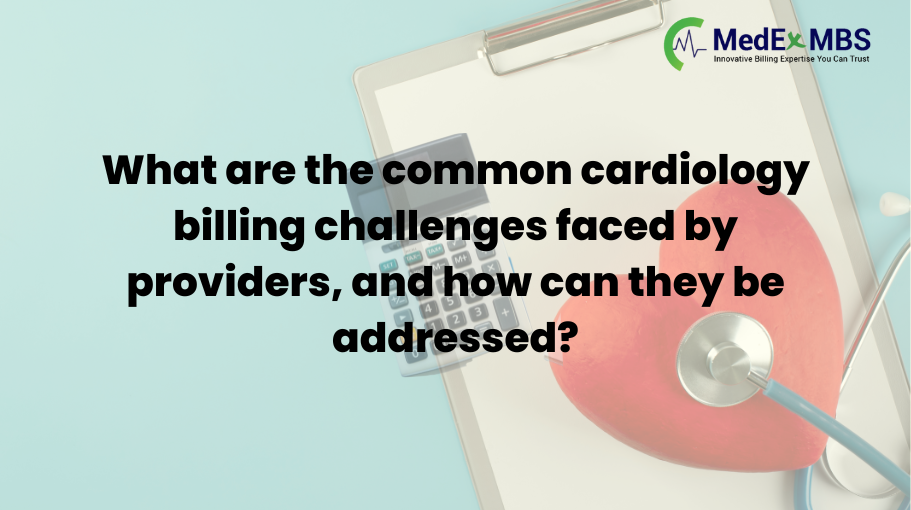What are the common cardiology billing challenges faced by providers, and how can they be addressed?

Introduction U.S. healthcare providers incur losses exceeding $125 billion annually due to billing inaccuracies. Cardiology practices specifically lose between 5% and 8% of their revenue due to claim denials, coding errors, and uncollected payments. These financial losses accumulate rapidly and can adversely affect the economic stability of any practice. The billing process in cardiology is intricate and labor-intensive, involving numerous procedures, evolving regulations, and stringent payer requirements. Minor errors frequently result in payment delays or claim rejections. Additionally, it offers straightforward and effective strategies to address these issues and safeguard your revenue. What Are the Challenges in Cardiology Medical Billing? The frequent updates in coding have rendered Cardiology Billing increasingly complicated. Stringent documentation requirements and escalating payer expectations imply that even minor mistakes can lead to lost revenue, denied claims, and compliance challenges. Below are the key challenges that cardiology practices currently encounter: Coding Complexity and Documentation Issues The bundling of procedures leads to confusion regarding cardiac catheterizations and PCI with stent placements. Tracking global periods for surgeries necessitates precise documentation of follow-up services. Proper application of modifiers (-26, -TC, -50, -RT, -LT, -59, -XS) is crucial to prevent claim denials. Each type of echocardiogram (2D, 3D, stress, contrast) requires the appropriate CPT code. Nuclear cardiology, cardiac MRI, and CT angiography demand accurate coding for various views and contrast usage. Electrophysiology studies and ablations must include comprehensive documentation to satisfy medical necessity criteria. The introduction of new ICD-10 codes for HFpEF necessitates clear documentation regarding the type of heart failure. Providers are required to differentiate between systolic and diastolic failure and indicate whether it is acute or chronic. Billing for CAD must document native vessels versus grafts, severity, and any complications. Documentation should provide evidence-based indications, a risk-benefit analysis, and alternative treatment options. Prior Authorization and Payer Management Advanced imaging techniques, such as MRI and nuclear studies, are subject to stringent approval regulations. Electrophysiology procedures and device implants frequently require multi-step approvals, which can delay patient care. The authorization process typically takes between 7 to 14 business days, hindering scheduling and cash flow. Emergency cases seldom receive retroactive approvals, and the success rate for appeals is low. The rules set by commercial payers differ by region and may incorporate conditions related to value-based care. Revenue Cycle Management Inefficiencies Elevated Denial Rates: 35% attributed to medical necessity 28% due to incorrect coding 22% for absent authorization 15% resulting from documentation deficiencies The clean claim rate is merely 78–82%, falling short of the 85–90% benchmark. Electronic Medical Records (EMR) and billing software frequently fail to synchronize, leading to missed charges. Eligibility checks and real-time updates often lack reliability. Staffing and Training Issues A shortage of certified coders and billers exacerbates errors. High employee turnover disrupts workflows and necessitates continuous retraining. Frequent Regulatory Changes Updates from CMS and revisions to ICD-10 require ongoing training efforts. Failure to remain up-to-date leads to denials or compliance audits. Front-End Intake Problems As many as 50% of denials originate from errors in patient demographics or insurance information. Missing referrals or incomplete eligibility verification can delay claims processing. Poor System Interoperability Electronic Health Records (EHR) and billing platforms often lack seamless integration. The absence of real-time data exchange hampers authorizations and claims processing. Manual Processes Manual workflows contribute to increased coding errors and slow processing times. Paper-based systems complicate scaling efforts and tracking of denials. Denials, Appeals, and Audit Risks The rates of denial in cardiology are 15–20% greater than those in primary care. Appeals can be expensive and often have a low success rate for documentation errors. The frequency of payer audits is increasing, which raises the compliance workload. Value-Based Care and Telehealth New quality-based care models necessitate detailed reporting and the use of different codes. Telehealth requires appropriate modifiers and adherence to payer-specific billing regulations. Patient Billing and Transparency Issues with balance billing lead to disputes and negatively affect patient trust. The absence of upfront cost estimates contributes to increased unpaid balances. Data Security and Compliance Achieving HIPAA compliance becomes more challenging with multiple digital systems in place. Incomplete documentation can lead to penalties and audits. How Do These Challenges Affect Providers? Billing issues in cardiology extend beyond administrative delays; they directly impact revenue. Denials, underpayments, and delayed payments all influence income. Revenue Loss Each denied or underpaid claim results in financial loss and consumes staff time. Numerous cardiology practices maintain overdue accounts for extended periods, which hampers cash flow and diminishes collections. Underpayments are particularly difficult to identify. If not monitored closely, they can go unnoticed. Over time, these minor losses accumulate and adversely affect the financial bottom line. AR Aging and Write-offs Most claims are expected to be settled within 30–45 days. However, many practices have claims that remain unpaid for over 90 days, significantly exceeding the industry average. The likelihood of payment decreases as claims age, with many ultimately being written off. Frequent write-offs indicate underlying issues, such as coding errors or inadequate follow-up. Additionally, older claims are more costly to recover, as time lost translates to money lost. Cost of Denials Challenging a rejected claim can incur significant expenses, varying from $25 to $118 for every claim. This expense encompasses staff time, administrative work, and follow-up efforts. Moreover, not all appeals are successful. When a denial is related to documentation or medical necessity, the chances of approval diminish significantly. Consequently, your team may invest considerable hours on appeals that do not yield payment. How to Address Cardiology Billing Issues Minor adjustments are insufficient to tackle the challenges associated with cardiology billing. It is essential to utilize intelligent tools, established processes, and expert assistance. Companies specializing in cardiology medical billing can aid practices in navigating these challenges and recovering lost revenue. Below are the solutions you should consider. Technological Solutions for Cardiology Billing Contemporary billing processes rely heavily on automation and data analytics. Utilizing the appropriate tools can help
